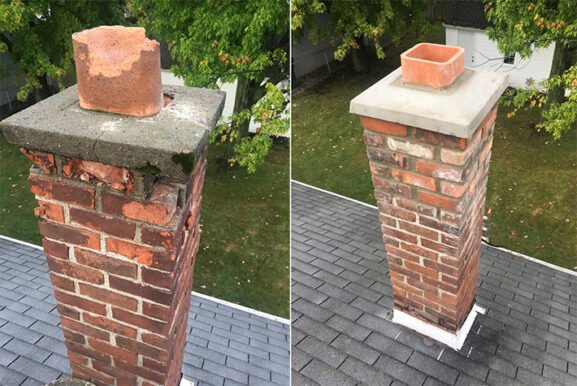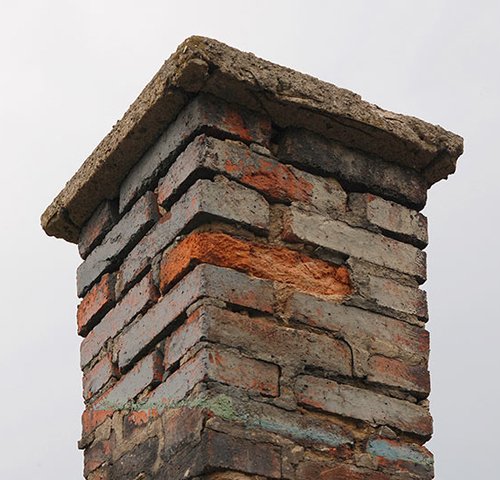Why Repairing a Damaged Chimney Crown Protects Your Home from Bigger Problems
Key Takeaways
- A cracked chimney crown can lead to serious moisture damage inside and outside your chimney system
- Repairing the crown early helps avoid expensive structural issues in the future
- Choosing the right repair method depends on the extent of damage and type of crown
- Annual chimney inspections help spot early warning signs and preserve your home’s safety
Understanding the Purpose of a Chimney Crown
The chimney crown is the topmost slab of concrete, mortar, or stone that covers and seals the opening of a masonry chimney. Its role is critical—it keeps rain, snow, and debris from entering the flue while directing water away from the chimney structure. When this component is in good condition, it helps prevent water intrusion, brick decay, and mortar deterioration.
Unfortunately, crowns are exposed to harsh weather and temperature swings year-round. Over time, even small cracks can lead to significant water damage inside your chimney and surrounding roofing materials. That’s why knowing when and how to repair a chimney crown is essential to maintaining your home’s long-term structural health.
How to Identify Signs of Chimney Crown Damage
Most homeowners don’t realize there’s an issue with their chimney crown until a leak appears indoors or the chimney starts to crumble on the outside. However, there are several early warning signs that suggest trouble is brewing above the roofline.
Look out for:
- Hairline cracks on the crown surface
- Pieces of concrete or mortar falling to the ground
- Water stains on the ceiling near the chimney
- Deteriorated bricks or mortar below the crown
- Moss or vegetation growing from the chimney top
If you notice any of these indicators, it’s time to schedule a professional chimney inspection. A certified chimney technician will be able to assess the severity of the damage and recommend a targeted repair approach.
What Causes Chimney Crowns to Fail Over Time
A variety of factors contribute to chimney crown damage. One of the biggest culprits is freeze-thaw cycles. When water enters small cracks in the crown and freezes, it expands, causing the cracks to grow. This cycle repeats with every temperature shift, leading to eventual crown failure.
Other contributors include:
- Poor construction or improper crown slope
- Lack of waterproof coating
- Aging materials and general wear and tear
- Lightning strikes or storm damage
In some cases, the chimney crown was improperly built to begin with, using mortar instead of concrete. Mortar is not designed to withstand weather exposure long term, making such crowns highly vulnerable.
Different Types of Chimney Crown Repairs
Not every damaged crown needs a full replacement. The right repair method depends on the extent of the damage and the material used in the crown’s construction. Here are the most common repair options:
Crown Sealing
If your crown has minor surface cracks but is structurally intact, a waterproof sealant can be applied to stop further water penetration. This is an affordable preventative fix that extends the crown’s lifespan. Crown sealants are flexible and expand with temperature changes, helping seal existing cracks.
Crown Patching
For more noticeable cracks or surface deterioration, a patching compound may be applied. The technician will clean the surface, remove loose materials, and rebuild the crown’s surface with a masonry repair mix. This is usually a mid-level solution for crowns that still have good overall structure.
Full Crown Rebuild
When a crown is severely cracked, missing chunks, or was constructed incorrectly, a full rebuild is the safest and most durable option. This involves removing the existing crown and pouring a new one using concrete, formed with a proper drip edge and slope for water drainage. A high-quality rebuild can last decades if maintained.
Why Timely Crown Repairs Prevent Bigger Issues
Delaying chimney crown repair can lead to moisture entering the flue, damaging the chimney liner, eroding mortar joints, and even compromising your home’s structural integrity. Water seepage from a broken crown may also lead to mold growth, staining, and wood rot in your attic and walls.
One of the most concerning long-term risks is spalling, a condition where bricks flake or crumble due to absorbed moisture freezing and expanding inside them. Once spalling begins, chimney repair becomes significantly more complex and costly.
To put it simply, acting early not only protects your chimney but also saves you money. According to the Chimney Safety Institute of America, annual inspections can catch crown and other chimney issues before they escalate into major repairs (source).
How Professionals Diagnose and Repair Crown Damage
A certified chimney professional will begin by examining the crown’s surface and structure. In many cases, they’ll use video inspection tools or drones to get a close look at hard-to-reach areas. They’ll also check for related issues, like cracked flue tiles or deteriorated flashing, which often accompany crown damage.
Depending on what they find, they’ll offer one of the repair methods mentioned earlier. It’s important to hire professionals with masonry experience and certification from organizations like the Chimney Safety Institute of America (CSIA) or the National Chimney Sweep Guild (NCSG). Their training ensures the work will meet modern safety and durability standards.
Long-Term Maintenance to Extend Chimney Crown Life
Once your chimney crown is repaired or rebuilt, it’s smart to implement a regular maintenance routine. Applying a waterproof crown coating every few years can shield the crown from moisture and UV damage. Annual inspections remain your best defense, as they can catch new cracks or signs of wear before they turn into major issues.
It’s also wise to install a quality chimney cap if one isn’t already in place. Chimney caps add an extra layer of protection by keeping rain, animals, and debris from entering your flue while reducing downdrafts.
Ensuring Long-Term Safety and Value for Your Property
A properly maintained chimney crown plays a vital role in preserving the overall health of your chimney system. While it may seem like a small feature, its failure can lead to expensive and extensive water damage throughout your home. By paying attention to early warning signs and acting on needed repairs, homeowners can protect both their property value and their peace of mind.
Whether you’re dealing with minor cracks or a severely deteriorated crown, investing in quality repair work is one of the smartest home maintenance decisions you can make.

